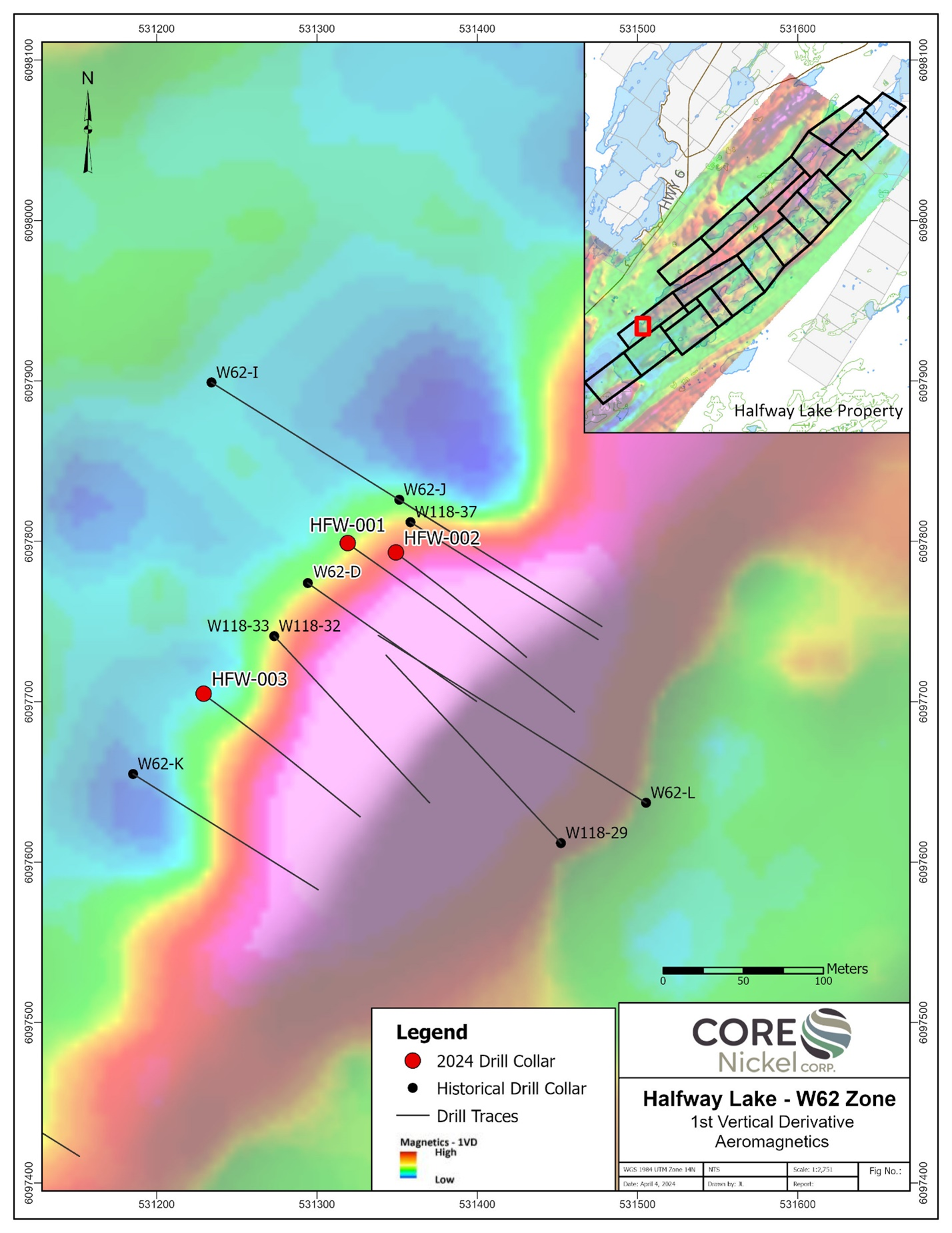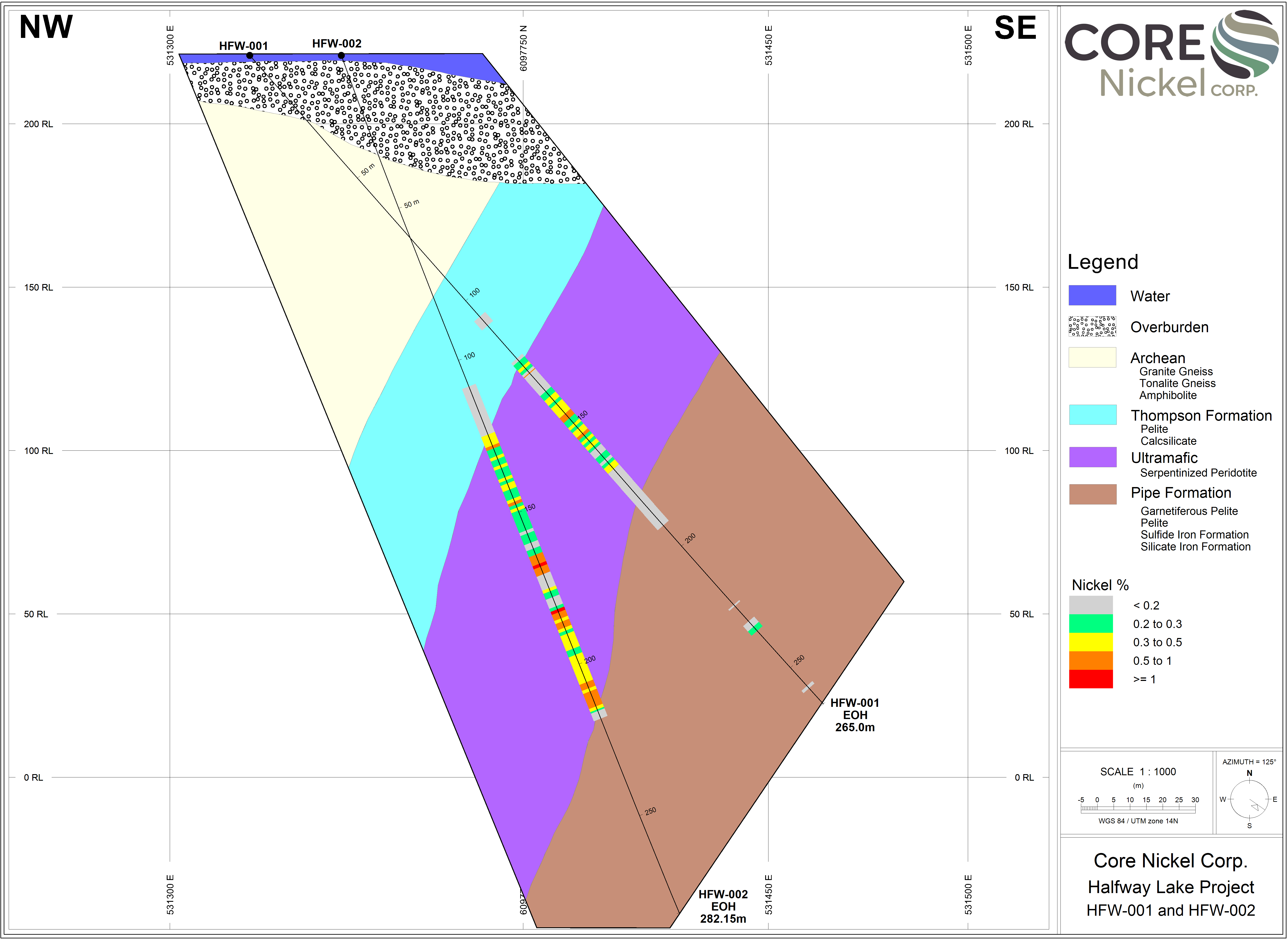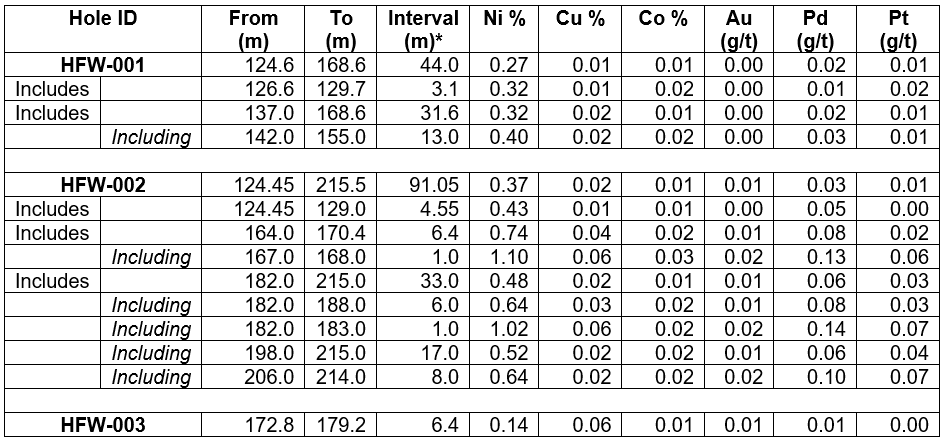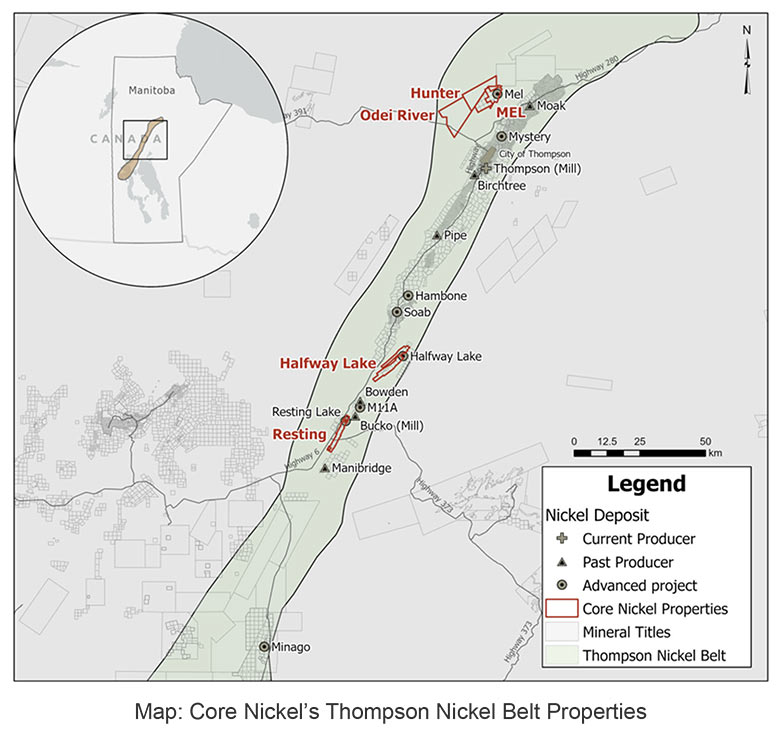Saskatoon, SK, Canada, May 21, 2024 – Core Nickel Corp. (CSE: CNCO) (“Core Nickel” or the “Company”) is pleased to report disseminated nickel-bearing sulfide mineralization with nickel tenors up to 17% in assay results from the 2024 winter drill program at the Company’s 100% owned Halfway Lake project (the “Project”) in the Thompson Nickel Belt, Manitoba (Figure 1).
Highlights:
As announced on April 8, 2024, the Company completed its 2024 winter drill program at the Company’s 100% owned Halfway Lake project. Core Nickel’s inaugural drill program set out to confirm and build on the geological framework presented from historical drilling at the W62 Zone. HFW-001 and HFW-002 intersected wide packages of serpentinized ultramafic rocks, containing disseminated nickel-bearing sulfide mineralization adjacent to the sulfide-rich Pipe Formation, confirming the geological framework and characteristics for significant Ni-sulfide mineralization on the Halfway Lake project. In addition, the high nickel tenors up to ~17% associated with the ultramafic-hosted, disseminated sulfide mineralization increases the prospectivity for economic nickel mineralization along the trend. Comparatively, sulfide mineralization from ultramafic rocks at the Birchtree Deposit has 4-6% Ni tenor range, whereas the Pipe Deposit has 3-9% Ni tenor range (Lightfoot et al., 2012).
The wide packages of serpentinized ultramafics rocks hosting disseminated nickel-bearing sulfide mineralization (Ni > 0.3%) in HFW-001 and HFW-002, and the localized 1.0 m intersections grading over 1.0% Ni in HFW-002, indicate the Halfway Lake project contains all the key characteristics to host a significant, magmatic sulfide nickel deposit. The sulfide-facies iron formation intersected at the contact of the ultramafics and Pipe Formation in HFW-001, and the highly-deformed sulfide-facies iron formation intersected in HFW-003 provide ideal sulfide sources to precipitate nickel mineralization when in close proximity to ultramafic intrusions. The results of the inaugural drill program in the W62 Zone have strengthened the exploration potential for the under-explored trend to the north which coincides with a 1.4 km magnetic anomaly 300 m north of the W62 Zone.
The next steps of the 2024 exploration program are to complete property-wide VTEM surveys on the Company’s Halfway Lake and Resting Lake projects. The high-resolution VTEM survey paired with further interpretation of the airborne QMAGT and Total Field Magnetics survey flown in 2021 on the Halfway Lake project, will refine targets on the trend to the north of the W62 Zone and throughout the Property.

Figure 1 – Halfway Lake Project Location

Figure 2 – Halfway Lake Project W62 Zone – 2024 Winter Drillhole Locations

Figure 3 –HFW-001 and HFW-002 Geological Cross-Section with Nickel Percent Plotted Downhole
Table 1: Drillhole Assay Summary

* Interval is not true thickness. Insufficient data currently to determine true thickness.
Table 2: Nickel Tenors

* Interval is not true thickness. Insufficient data currently to determine true thickness.
**Sulfur (%) was analyzed using LECO Induction Furnace method
*** Nickel tenor is defined as the calculated nickel concentration in 100% sulfides. Note in the case above Ni tenor is calculated using the equation: Ni tenor = (Ni%x38)/S%, using assays with a value greater than 0.25% Ni and 1.0% S, with the evidence that the mineralization comprises a magmatic assemblage of pyrrhotite, pentlandite, and chalcopyrite.
Table 3: Drillhole Location Summary

*UTM Projected Coordinate System: WGS 1984 UTM Zone 14N
The 2024 drill program expanded on the Technical Report on the Halfway and Resting Lake Properties Thompson, Manitoba, prepared by Chris Beaumont-Smith in 2023, filed under the Company’s profile on SEDAR+.
Misty Urbatsch, CEO, comments: “Assays confirming nickel-bearing sulfide mineralization associated with a broad ultramafic package, coupled with notable nickel tenors up to 17%, highlight the exploration potential of the Halfway Lake property. We now know we have the components to generate a nickel sulfide deposit on the Halfway Lake property, and we plan to further develop our knowledge of the geological framework by conducting a property-wide VTEM Survey this summer. In conjunction with Halfway Lake, Core Nickel will also run a property-wide VTEM survey on the Company’s 100% owned Resting Lake property, which has very similar geology to Halfway Lake. Core Nickel has an exceptional land position in the Thompson Nickel Belt, Manitoba and we are keen to continue to make progress on multiple properties in our portfolio to increase our potential for success.”
Core Nickel Vice President Exploration, Caitlin Glew, comments: “Core Nickel’s inaugural drill program confirmed and built on the geological framework presented from historical drilling at the W62 Zone. HFW-001 and HFW-002 intersected a wide package of serpentinized ultramafics with disseminated nickel-bearing sulfide mineralization throughout. Seeing local grades above 1.0% Ni in the disseminated mineralization, paired with the high nickel tenors indicates we have the right ingredients for significant nickel mineralization along the trend. The team is looking forward to the results of our VTEM survey this summer to incorporate with our aeromagnetics and winter drill results to refine targets along the trend to the north of the W62 Zone and throughout the Halfway Lake project.”
Nickel Tenors
The viability of most deposits is determined mainly by two factors: tonnage and grade. In magmatic nickel (Ni) deposits, however, another factor, known as tenor, often makes or breaks a deposit. Nickel tenor is defined as the concentration of nickel contained in 100% sulfides. This is the nickel that can be extracted from the ore. High tenor magmatic deposits can be very economically attractive because they can have much higher grades than laterite Ni deposits, produce valuable byproducts, and consist of easily processed ore minerals.1
1Burron, I. (2021, November 17). Tenor and Magmatic Ni Deposits. Geology for Investors. https://www.geologyforinvestors.com/tenor-and-magmatic-ni-deposits/
Geochemical Sampling Procedures
All drill core samples were shipped to Saskatchewan Research Council Geoanalytical Laboratories (SRC) in Saskatoon, Saskatchewan in secure containment for preparation, processing, and ICP-OES analysis for major and minor elements and ICP-MS analysis for trace elements using total 4-acid digestion (HF:HNO3:HCl:HClO4). All assay samples are analyzed for gold, platinum, and palladium using the AU5 Fire Assay Technique. Assay samples comprise 0.3 – 1.7 metre, generally 1.0 metre, continuous split-core samples over the sulfide mineralized intervals. Select assays samples were re-analyzed for sulfur (%) using the LECO Induction Furnace method, to confirm sulfur values obtained by ICP-OES analysis. The SRC is an ISO/IEC 17025/2005 and Standards Council of Canada certified analytical laboratory. Blanks, standard reference materials, and duplicates are inserted into the sample stream at regular intervals by Core Nickel and the SRC in accordance with Core Nickel’s quality assurance/quality control (QA/QC) procedures. Geochemical assay data are subject to verification procedures by qualified persons employed by Core Nickel prior to disclosure.
All reported depths and intervals are drillhole depths and intervals, unless otherwise noted, and do not represent true thicknesses, which have yet to be determined.
References
Lightfoot, P.C., Macek, J., Stewart, R., Gribbon, G., Mooney, S. (2012). Relative contribution of magmatic and post-magmatic processes in the genesis of the Thompson Belt Ni-Co sulphide ore deposits, Manitoba, Canada. 11th International Nickel Symposium, Abstract: Guiyang China (2012)
About Core Nickel
Core Nickel Corp. is a junior nickel exploration company that controls 100% of five properties in the prolific nickel district, the Thompson Nickel Belt (TNB) in Northern Manitoba, Canada. The five properties consist of approximately 27,000 hectares of land that is proximal to existing infrastructure, such as highways and operating mills.

Core Nickel has a large contiguous land package in the northern part of the TNB, situated approximately 16-20 km from the City of Thompson. Core Nickel’s northern TNB projects consist of three properties: Mel, Hunter, and Odei River. The Mel property encompasses the Mel deposit, which is characterized by a historical NI-43-101 resource estimate with an indicated resource of 4.3 million tonnes at 0.875% nickel, equating to 82.5 million lbs contained nickel, and a historical inferred resource estimate of 1.0 million tonnes at 0.839% nickel, equating to 18.7 million pounds of contained nickel2. The target stratigraphy (Pipe Formation) that hosts the Mel deposit, and other deposits in the Thompson Nickel Belt, extend onto the Hunter and Odei River properties and drillhole intersections into the target stratigraphy on the Hunter project have successfully intersected elevated nickel.
2 “Technical Report on the Mel Deposit, Northern Manitoba” prepared for Victory Nickel Inc, Shane Naccashian (P. Geo) of Wardrop Engineering Inc., March 9, 2007
The Company also holds two properties in the southern TNB near Wabowden: Halfway Lake and Resting Lake. Both properties host the target Pipe Formation associated with known elevated nickel mineralization and are proximal to existing nickel deposits, mills, and other infrastructure.
The Qualified Person under National Instrument 43-101 Standards of Disclosure for Mineral Projects for this news release is Caitlin Glew, P. Geo., Vice-President Exploration for Core Nickel Corp., who has reviewed and approved its contents.
Technical Disclosure
The historical results contained within this news release have been captured from Manitoba Integrated Mining and Quarrying System (“iMaQs”) as available and may be incomplete or subject to minor location inaccuracies. Management cautions that historical results were collected and reported by past operators and have not been verified nor confirmed by a Qualified Person but form a basis for ongoing work on the subject properties.
On behalf of the Board of Directors
“Misty Urbatsch”
Misty Urbatsch
CEO, President and Director
Core Nickel Corp.
Contacts:
| Misty Urbatsch, CEO and President |
General Enquiry |
| Tel: 306-668-6927 | Tel: 306-668-6927 |
| Email: [email protected] | Email: [email protected] |
Neither the Canadian Securities Exchange nor its regulations services accept responsibility for the adequacy or accuracy of this release.
Forward-looking information
All statements included in this press release that address activities, events or developments that the Company expects, believes or anticipates will or may occur in the future are forward-looking statements. These forward-looking statements involve numerous assumptions made by the Company based on its experience, perception of historical trends, current conditions, expected future developments and other factors it believes are appropriate in the circumstances. In addition, these statements involve substantial known and unknown risks and uncertainties that contribute to the possibility that the predictions, forecasts, projections and other forward-looking statements will prove inaccurate, certain of which are beyond the Company’s control. Readers should not place undue reliance on forward-looking statements. Except as required by law, the Company does not intend to revise or update these forward-looking statements after the date hereof or revise them to reflect the occurrence of future unanticipated events.